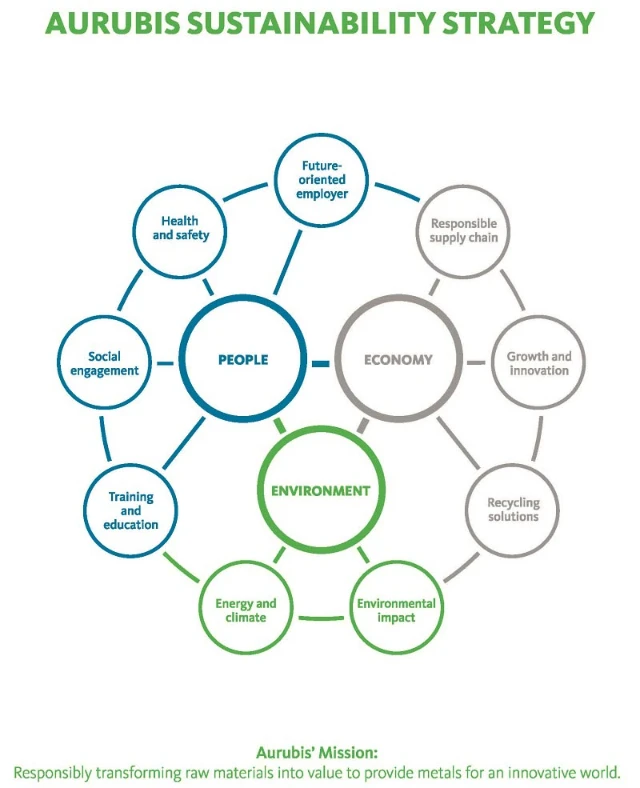
Sustainability
For Aurubis, responsible corporate governance makes an integral contribution to securing the company's future. The Sustainability Strategy 2018-2023 creates the framework for this. It is a component of the Aurubis Group strategy and encompasses the focuses of people, the environment, and the economy.
The Sustainability Strategy 2018-2023 establishes the main areas of activity, targets, and action plans for the coming years. Aurubis has systematically structured and expanded its sustainability activities over the past several years – from its sustainability reporting to the development of the first Sustainability Strategy in 2013.
We report the status of target achievement annually in our Non-Financial Report.

People
Strategic Approach
It is a matter of course for us to maintain our employees’ health and productivity and to protect them from accidents and illness. We don’t distinguish between our own employees, external employees, or visitors in this respect. At the same time, this helps us avoid economic damages that arise when employees are absent due to accidents or illnesses.
Target
We want to avoid work-related accidents, injuries, and illnesses (Vision Zero)
Key measures
Preparing all sites for the introduction of the ISO 45001 standard for occupational health and safety (by FY 2019/20)
Implementing Behavior-Based Safety across the Group (by FY 2020/21)
KPI
LTIFR (on-the-job accidents with lost time*): target of ≤1.0 (by FY 2021/22)
*at least one lost full shift
Strategic Approach
Our human resources strategy supports the successful implementation of the Aurubis strategy and is thus a key element on the path to Vision 2025. This is how we lay the foundation for successfully confronting future challenges of human resources policy.
Target
We have set the targets of creating a work environment for good, close cooperation and promoting involvement and creativity. We form a team that passionately works toward progress.
Key Measures
Improving the “health” of the organization with strategically aligned HR instruments and services, as well as individual development tools
Regularly identifying employees’ needs with respect to working time arrangements
Developing a Diversity Policy
KPIs
Organizational Health Index
Diversity Index (age structure, international quality, percentage of female employees; index under development)
Strategic approach
We provide high-quality training and invest in qualifications for our employees. In this way, we secure our company’s long-term success.
Target
We have set the target of providing qualifications to our employees, continuously strengthening their skills, and promoting their development to ensure mutual success and motivation.
Key measures
Regularly identifying qualification needs to expand project, process, and management expertise in a targeted way (by FY 2022/23)
Group-wide introduction of the Aurubis Operating System (AOS) pillar “training and education” (by FY 2022/23)
Ensuring group-wide knowledge management to identify, preserve, transfer, and enhance knowledge across functions (by FY 2022/23)
KPIs
Training hours used for development measures: target of 18 hours per full-time employee per year by FY 2022/23
Employee participation in AOS: targets by FY 2022/23 (base year: 2017/18)
- Inclusion of employees in pillar activities: target of over 90 %
- Inclusion of employees in the performance management system: target of over 90 %
- Active employee participation in improvement teams: target of over 20 %
Strategic approach
Social commitment is a fixed component of our company identity. We are aware of the responsibility we assume with our business activities – as an employer, as a business partner, as a neighbor, and as part of society.
Target
We have set the target of contributing to a livable environment for future generations. In the process, we focus on areas of action that are linked with Aurubis’ key expertise. As a responsible, committed company, we want to promote enthusiasm for our company and for our work.
Key measure
Developing and implementing a strategy for societal engagement at group level (by FY 2018/19)
Environment
Strategic Approach
We take responsibility for our environment and protection of the climate. As an energy-intensive company, the effective and efficient use of energy and the reduction of CO2 emissions are issues of ecological and economic responsibility.
Target
We have set the target of further increasing our energy efficiency and reducing CO2 emissions wherever possible.
Key measures
- Introducing the ISO 50001 standard for energy management across the Group (by FY 2021/22)
- Increasing flexibility in electricity purchasing
- Energy efficiency projects (such as increased heat extraction for supplying district heating and internal company electricity projects)
- Investigating processes and electricity consumption in relation to the German Climate Action Plan 2050 and analyzing the requirements for new investments (starting FY 2018/19)
- KPIs
- More flexibility in electricity use: 10 % target by FY 2022/23
- CO2 emissions; target: reduction > 100,000 t by FY 2022/23 (base year: 2012/13)
Strategic approach
We take responsibility for our environment and protection of the climate. For all production sites and across all business processes, we therefore place an emphasis on modern and energy-efficient plant technology, which complies with very high environmental standards.
Target
We have set the target of conserving natural resources and maintaining a clean environment for future generations.
Key measures
- Introducing the ISO 14001 standard for environmental management across the Group (by 2022*)
- Reducing specific metal emissions to water in multi-metal production with site-specific projects and individual measures
- Reducing specific dust emissions to air in multi-metal production with site-specific projects and individual measures
Reducing specific SO2 emissions to air with site-specific projects and individual measures
KPIs
- Specific metal emissions to water; target: 40 % reduction by 2022* (base year: 2012*, copper production)
- Specific dust emissions to air; target: 15 % reduction by 2022* (base year: 2012*, copper production)